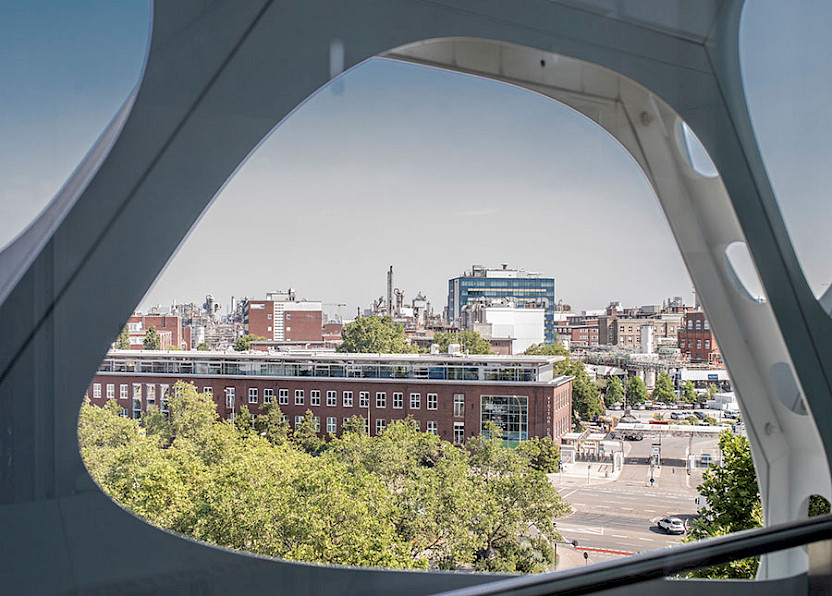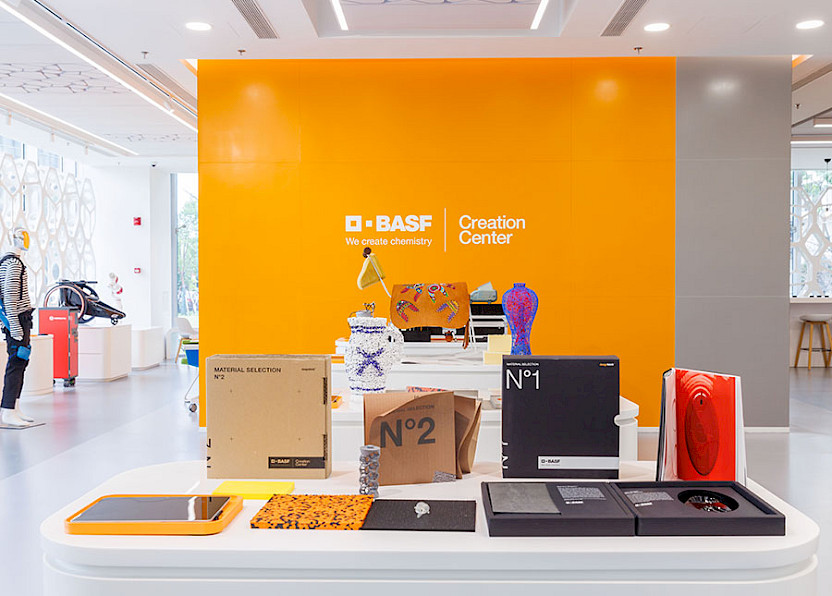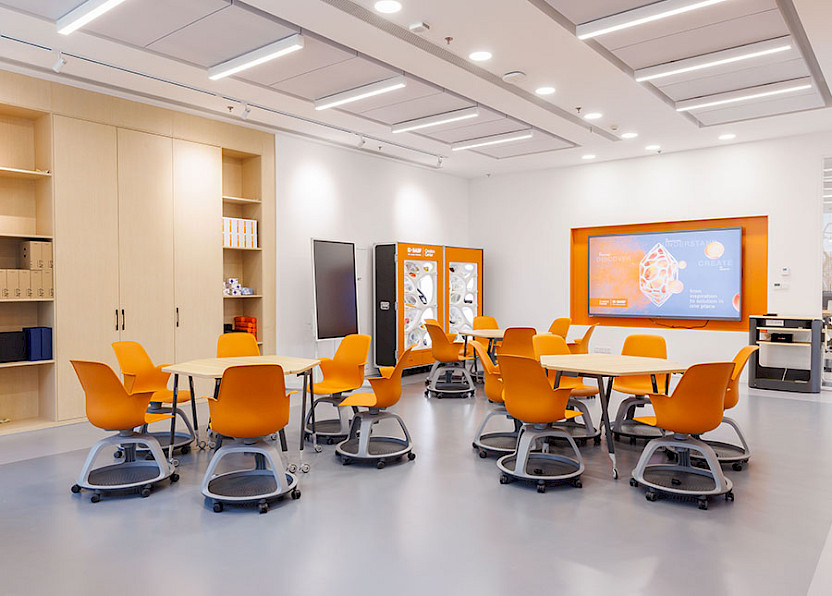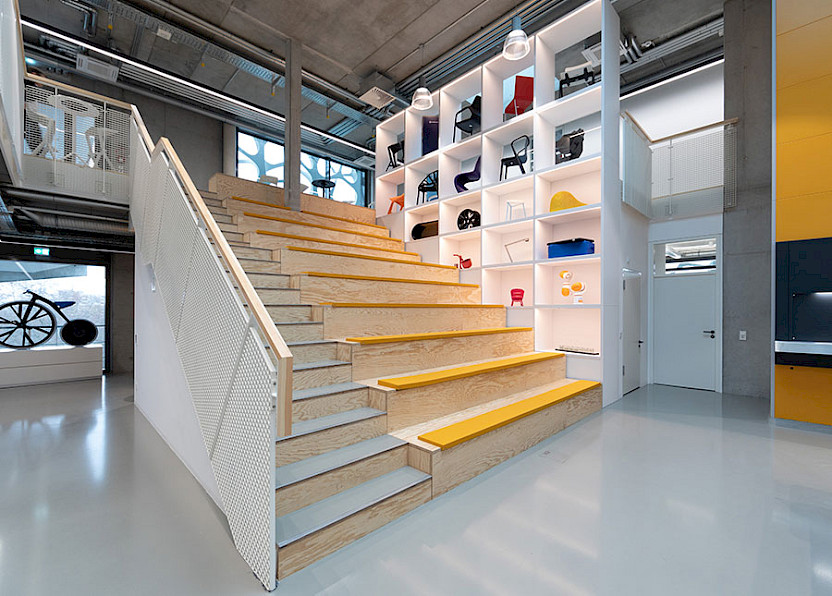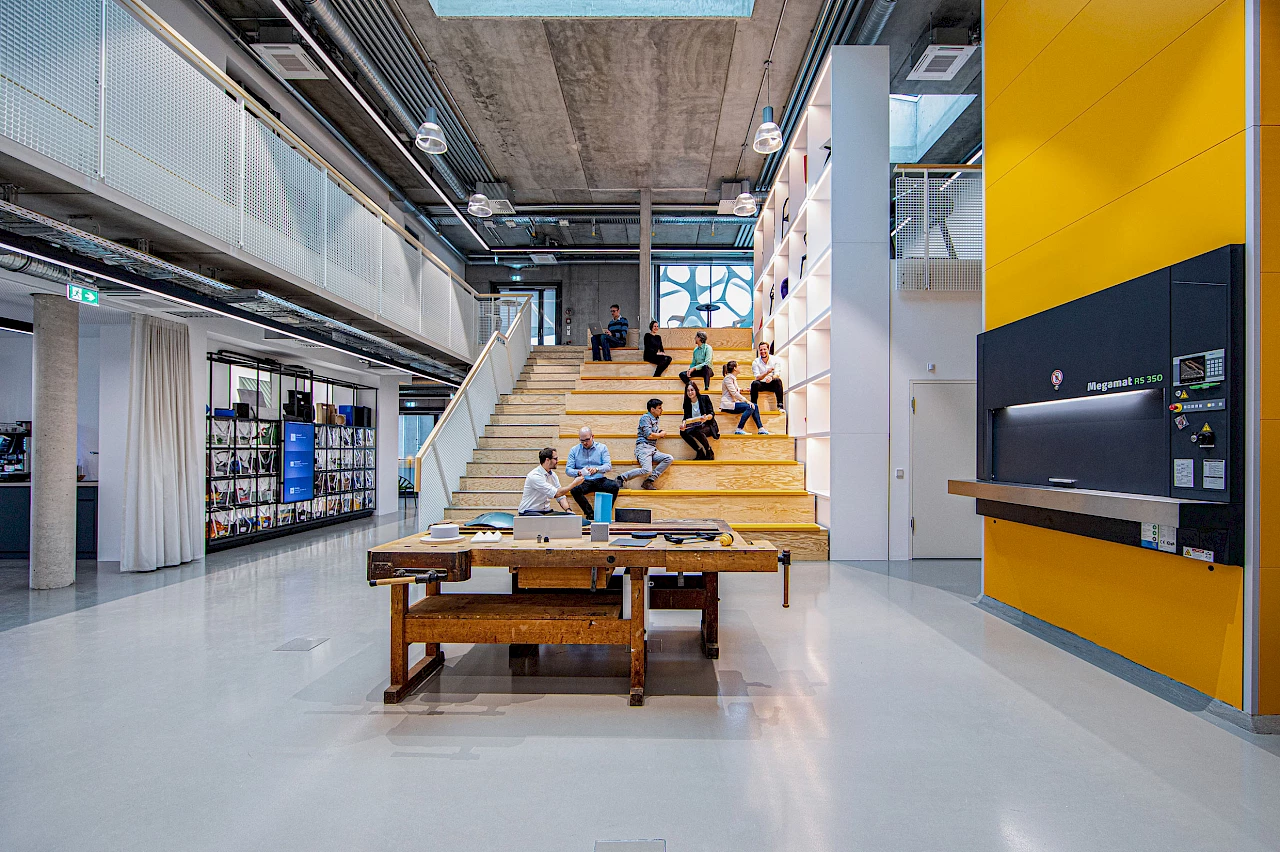The Creation Center Europe is located on top of a former air raid shelter, directly next to the company’s biggest corporate site in Ludwigshafen. In this listed building, visitors can gain an insight into the world of BASF Performance Materials. This is a place where materials can be analysed and where the designers, engineers and developers of BASF customers receive support during the early phase of the innovation process. The editorial staff of the IBA Forum talked with Andreas Mägerlein and Eva von Traitteur about technology, innovation and the impact of spaces.
Mr Mägerlein, Ms von Traitteur, how long has the Creation Center Europe existed, and what aims are you pursuing there?
Andreas Mägerlein: The history of the Creation Center goes back to 2006, when the designfabrik® was established — at that time it was on the plant site — as a point of contact for designers who had questions related to the colouring of plastics. We subsequently expanded our product range over the years and focused more on technologies, plastics processing and the use of plastics. In 2016 we finally opened the Creation Center just outside the plant gates. The goal of the Creation Center is to establish a place where our customers can develop innovative products together with our in-house experts in an inspiring atmosphere.
Eva von Traitteur: The idea was to create spaces that are both functional and inspiring. We wanted to shape a place where designers, engineers and developers can discuss their ideas and work creatively. The Creation Center offers exactly this unique atmosphere.
What design approaches does the Creation Center use, and how do its spaces support innovation processes?
Eva von Traitteur: The design of the Creation Center was developed from the inside out. We oriented ourselves according to the users’ needs and designed the spaces in a way that offers various options for working and interacting. The materials library is the core of the Creation Center and a source of inspiration. Using it as a basis, we designed conference rooms and open areas where people can work on the problems directly and where inspiration can ultimately be transformed into a product. That was the vision for the Creation Center. And that’s why the subline of the Creation Center is “Discover – Understand – Create”. These are the three phases people go through in the Creation Center. Customers can discover our world of materials in the atrium, understanding takes place in the conference rooms, and creation happens subsequently — in many cases only after the customers are back at the company.
Andreas Mägerlein: The floating platforms are a key design element. There is also an atmosphere of openness in areas such as the atrium, and the special façade that depicts the chemical development of foam structures. These special architectural features contribute to the spatial atmosphere and make the building a place of innovation. In particular, the many visual axes create a variety of perspectives that convey new impressions to the visitor again and again. I can let my gaze sweep across the Palatine Uplands in the distance or look into the factory. These are factors that are valuable for creative and innovative processes. People like to use the atrium in particular as a combination of a lecture hall and a workshop. The lecture hall is a place for presentations and discussions, whereas people can work on the development of prototypes in the workshop. It’s precisely this proximity of theory and practice that makes the Creation Center so special.
What’s behind the materials library?
Andreas Mägerlein: The materials library is the core of the Creation Center. It offers access to hundreds of product samples and enables users to directly experience the properties and opportunities offered by our materials. It also enables them to gather technical information about a product that can then be passed along to a collaboration tool. In short, you could say that the library serves as a source of inspiration and supports our customers as they develop and implement new ideas.
What sustainability aspects were taken into account when you were planning the spaces?
Eva von Traitteur: Sustainability was a central aspect of the planning of the Creation Center. We have a well-insulated façade, and we use an innovative climate system that uses river water as an energy source and is especially efficient thanks to a heat recovery system. In addition, we took into account the requirements for the preservation of historic buildings and planned the building in a way that complies with present-day standards for energy efficiency and sustainability.
How do the spaces and tools in the Creation Center support cross-functional cooperation?
Andreas Mägerlein: Open work areas, flexible conference rooms and our central materials library create an environment in which designers, engineers and developers can work together in an inspiring atmosphere. Proximity and direct discussions are important for innovation processes. Together with experts from BASF, our customers can work in a supportive environment in a process that moves seamlessly from design to product improvement and all the way to prototype development. There, they can use interactive digital tools and participate in workshops on idea generation and materials consultation. The choice of methods is always directed by the needs of the respective customer. The options range from traditional workshops to special techniques such as agile methods.
Please also read
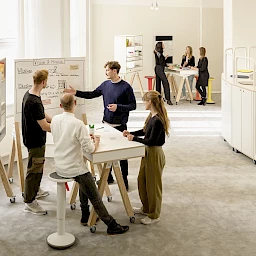
What role does technology play in the development of new product ideas?
Eva von Traitteur: It plays a very central role. Technology enables us to simulate complex processes, create prototypes faster and test new materials. At the same time, it’s an important component of our workshops and innovation processes, because it helps the participants to visualise their ideas and develop them further. We use state-of-the-art technologies, such as the simulation of the production process of plastic components, in order to optimally support our customers and help them develop innovative and marketable products.
BASF has other Creation Centers all over the world. Do they have the same spirit, or are there differences?
Eva von Traitteur: All of the Creation Centers worldwide share the same basic idea and the same spirit. Nonetheless, there are differences that can be traced back to cultural and regional distinctions. In addition to the Creation Center in Mumbai, which was built after ours, there are centres in Shanghai and Yokohama, which were originally launched as designfabrik facilities. Back then we developed a style guide that sets certain requirements regarding what a Creation Center should look like. The façade, which shows the chemical development of foam structures as well as a molecular structure and their composite nature, is made up of a recurring element that is used either in the façade or as 3D elements in the interior of the building. In addition, we decided on the colour orange, which is one of the six corporate colours of BASF.
Andreas Mägerlein: That’s right. Although we’re trying to achieve a certain amount of uniformity in order to ensure recognizability — especially for our global customers who visit various different Creation Centers — we’ve nonetheless made some regional adaptations. In China, for example, our colleagues prefer a “high-tech” atmosphere instead of a workshop environment. These cultural differences flow into the design of the individual centres. However, the overarching goal — creating an inspiring environment in which innovative ideas can arise — remains the same everywhere.
Thank you for this talk and the look inside the Creation Center.
